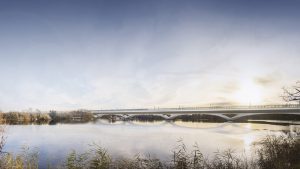 HS2 has started the work on the UK’s longest railway bridge, with an expert team of ground engineers sinking the first of almost 300 piles that will form the foundations for the Colne Valley viaduct.
HS2 has started the work on the UK’s longest railway bridge, with an expert team of ground engineers sinking the first of almost 300 piles that will form the foundations for the Colne Valley viaduct.
The high–speed rail viaduct will have a length of 3.4 km crossing a series of lakes and waterways on the north west outskirts of London. The Colne Valley viaduct will be almost one km longer than the Forth Rail Bridge and carry trains travelling at speeds of up to 200 mph (320 km/h).
Set low in the landscape, the design was inspired by the flight of a stone skipping across the water, with a series of elegant spans, some up to 80 metre – long, carrying the railway around 10 metres above the surface of the lakes, River Colne and Grand Union Canal which starts in London and ends in Birmingham.
The structure will be supported by 56 piers, with the widest spans reserved for where the viaduct crosses the lakes, and narrower spans for the approaches. This design was chosen to enable views across the landscape, minimise the viaduct’s footprint on the lakes and help complement the natural surroundings.
Over the next year, engineers from HS2 Ltd’s main works contractor Align joint venture, a team made up of Bouygues Travaux Publics, Sir Robert McAlpine, and VolkerFitzpatrick, will construct 292 piles under the ground to support the viaduct piers.
On top of each group of piles, some of which will go up to 55 metres into the ground, a concrete pile cap will support the pier which will in turn support the full 6,000 tonne weight of the bridge structure above. Instead of hammering the piles into the ground, holes will be bored before being backfilled to create the pile.
The main deck of the viaduct will be built in sections at a temporary factory nearby before being assembled from north to south.
Share on:



